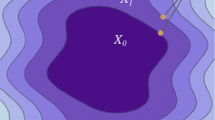Abstract
In this paper we establish the new notion of persistence distance for discrete signals and study its main properties. The idea of persistence distance is based on recent developments in topological persistence for assessment and simplification of topological features of data sets. Particularly, we establish a close relationship between persistence distance and discrete total variation for finite signals. This relationship allows us to propose a new adaptive denoising method based on persistence that can also be regarded as a nonlinear weighted ROF model. Numerical experiments illustrate the ability of the new persistence based denoising method to preserve significant extrema of the original signal.
Similar content being viewed by others
References
Almansa, A., Ballester, C., Caselles, V., Haro, G.: A TV based restoration model with local constraints. J. Sci. Comput. 34(3), 209–236 (2008)
Bauer, U., Lange, C., Wardetzky, M.: Optimal topological simplification of discrete functions on surfaces. Discret. Comput. Geom. 47(2), 347–377 (2012)
Bauer, U., Schönlieb, C.-B., Wardetzky, M.: Total variation meets topological persistence: a first encounter. AIP Conf. Proc. 1281, 1022 (2010)
Bertrand, G.: On topological watersheds. J. Math. Imaging Vis. 22(2–3), 217–230 (2005)
Carlsson, G., Zomorodian, A., Collins, A., Guibas, L.: Persistence barcodes for shapes. In: Proceedings of the Eurographics/ACM SIGGRAPH Symposium on Geometry Processing, pp. 124–135 (2004)
Chambolle, A., Darbon, J.: On total variation minimization and surface evolution using parametric maximum flows. Int. J. Comput. Vis. 84, 288–307 (2009)
Chambolle, A., Pock, T.: A first-order primal-dual algorithm for convex problems with applications to imaging. J. Math. Imaging Vis. 40, 120–145 (2011)
Chan, T.F., Osher, S., Shen, J.: The digital TV filter and nonlinear denoising. IEEE Trans. Image Process. 10(2), 231–241 (2001)
Chen, C., Edelsbrunner, H.: Diffusion runs low on persistence fast IEEE International Conference on Computer Vision (ICCV), pp. 423–430 (2011)
Cohen-Steiner, D., Edelsbrunner, H., Harer, J.: Stability of persistence diagrams. Discret. Comput. Geom. 37, 103–120 (2007)
Cohen-Steiner, D., Edelsbrunner, H., Harer, J., Mileyko, Y.: Lipschitz functions have L p -stable persistence. Found. Comput. Math. 10, 127–139 (2010)
Dong, Y., Hintermüller, M., Monserrat Rincon-Camacho, M.: Automated regularization parameter selection in multi-scale total variation models for image restoration. J. Math. Imaging Vis. 40, 82–104 (2011)
Edelsbrunner, H., Letscher, D., Zomorodian, A.: Topological persistence and simplification. Discret. Comput. Geom. 28, 511–533 (2002)
Grasmair, M.: The equivalence of the taut string algorithm and BV-regularization. J. Math. Imaging Vision 27, 59–66 (2007)
Grasmair, M.: Locally adaptive total variation regularization, SSVM, Lecture Notes in Computer Science, vol. 5567, pp. 331–342. Springer, Berlin (2009)
Roerdink, J.B.T.M., Meijster, A.: The watershed transform: definitions, algorithms, and parallelization strategies. Fundam. Inform. 41, 187–228 (2000)
Rudin, L., Osher, S., Fatemi, E.: Nonlinear total variation based noise removal algorithms. Phys. D 60, 259–268 (1992)
Strong, D.M., Aujol, J.-F., Chan, T.F.: Scale recognition, regularization parameter selection, and Meyer’s G norm in total variation regularization. Multiscale Model. Simul. 5(1), 273–303 (2006)
Strong, D.M., Chan, T.F.: Spatially and scale adaptive total variation based regularization and anisotropic diffusion in image processing. Diffusion in Image Processing, UCLA Math Department CAM Report 96-46 (1996)
Zomorodian, A., Carlsson, G.: Computing persistent homology. Discret. Comput. Geom. 33(2), 249–274 (2005)
Author information
Authors and Affiliations
Corresponding author
Additional information
Communicated by: Tomas Sauer
Rights and permissions
About this article
Cite this article
Plonka, G., Zheng, Y. Relation between total variation and persistence distance and its application in signal processing. Adv Comput Math 42, 651–674 (2016). https://doi.org/10.1007/s10444-015-9438-8
Received:
Accepted:
Published:
Issue Date:
DOI: https://doi.org/10.1007/s10444-015-9438-8




